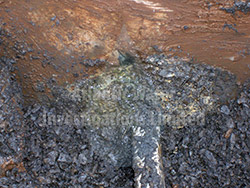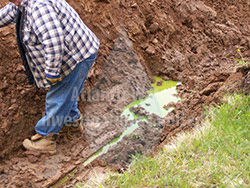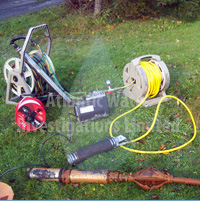
 BBB RATING: A+
|
 |
|
||||
|
|
|
|
|
|||
|
Septic Systems Dye Testing Dye testing is used to locate active service connections in main lines and/or trace existing lines. For example, you have a cross connection in a sewer or storm drain coming from a multiplex, you are able to put dye in each unit via the toilet or sink, and eliminate who is connected to what.
Dye testing is also used to determine which lines are leaking liquids simply by adding different colors of dye to different lines. It is a very environmentally safe, cost-effective.
Coloured dye is added to the storm drain water. Dyed water appearing in the sanitary sewer system indicates an existing connection between the sewer and storm drain system. Also, coloured dye can be added to the sewer connection through an on-site fixture (toilet, sink, etc.) to help determine the approximate connection point to the City sewer system.
One of the methods being used to survey the sewer lines is non-toxic dye testing. After an extensive investigation and documentation of defects is completed, a rehabilitation plan can be developed, identifying necessary sewer repairs and replacement. In severe situations, immediate repair may be required. What is dye testing and why is it conducted?
QP2 Qualified Non-Invasive Pre-Existing Septic Field Surface Visual Inspection Services (with Septic Dye Test) A fluorescein dye test and partial hydraulic load test of the septic system is conducted for monitoring purposes to see if effluent may discharge to the surface within the vicinity of the septic tank, suspected location of the septic disposal field or somewhere within the vicinity of the septic disposal system. Atlantic Water Investigations Limited uses specialized fluorescent dye. Field investigation is carried out by Atlantic Water Investigations Limited; Dean Walker, M.A.Sc., P.Geo. a QP (Qualified Person) licensed and Certified by the Nova Scotia Department of the Environment (NSE) in 1996 to perform On-Site Sewage Disposal Septic System Assessments, Inspections, Selection & Final Approval, Lic. No.38. The inspection is intended to provide a general record of the surficial condition of the property with emphasis placed on the location and severity of existing features especially evidence of probable sewage. The inspection is a non invasive investigation. There is no digging into the field or digging up of the septic tank. This is a visual site assessment of the current condition of the property and suspected location of the septic disposal system. Our fee covers the initial site visit not follow-up visits. Follow-up visits can be performed by the client or additional site visits by our company for additional fees and lab sampling analysis. A fluorescein dye test and partial hydraulic load test of the septic system is conducted for monitoring purposes to see if effluent may discharge to the surface within the suspected vicinity of the septic tank, suspected location of the septic disposal field or somewhere within the vicinity of the septic disposal system. Atlantic Water Investigations Limited uses specialized fluorescent dye. This is not a 50 cent dye puck claimed to be used by other camera inspection companies, who are not licensed with NSE to provide knowledge or advice as to how much dye needs to be used, what the volume of water needs to be run to activate the dye or how to conduct a QP Septic Field Inspection and what to look for. Our liquid dye tracers are biodegradable and nontoxic. Our dyes diffuse rapidly in water, producing a vivid, easy-to-see color. Excellent for identifying diffusion and dispersion patterns, rates of flow, discharge locations, seepage areas, sea marking, and more. Fluorescent yellow/green dye (fluorescein) works best in septic/silt filled waters. The dye test, is a useful, somewhat controversial, and not conclusive test of a system involving placing a tracer dye in a toilet, flushing the dye into the system and running a reasonable test volume of water into the system to look for signs of blockage in the building, backup in the building, or breakout of effluent (possibly dyed) anywhere on or around the property.
There is no question that this procedure is useful in that it has disclosed numerous septic failures and has proven that preexisting wet areas did, in fact come from the septic system. It will NOT find every failure condition, which is why the work outlined in the recommendations of our report based on our initial site visit are required to be performed. QP Qualified Non-Invasive Pre-Existing Septic Field Inspection with Septic Dye Testing is not able to be properly conducted during frozen ground and or winter snow-covered ground conditions, as we cannot see ground below snow. If a client observes signs of obvious features of pooling effluent (which can be roof drain or foundation drainage), pungent odour effluent observed, drainage ditches or surface water bodies around property, this inspection is recommended. In order to conduct a visual of the dye exiting the septic tank to the septic field and/or the septic field pipeline inspection, the access cover at the end of the septic tank over the outlet pipe has to be dug up and removed, then gently put back in place by the seller or whoever digs up the tank. These covers have usually never been removed and are tightly sealed into place and difficult to remove, which is why they need to be removed before I come out. Also I need to know how deep the outlet pipe in the tank is in order to determine if I can push the camera to the septic field (works best if the pipe is less than one foot below the top of the ground so I can reach with the camera head by hand to install it into the outlet pipe. Dye Testing Challenges:
|
|
|||||
|
|
||||||
|
|
|
|
|
|||
|
|
|
|||||
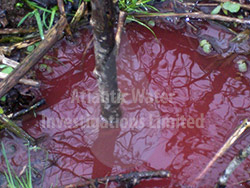
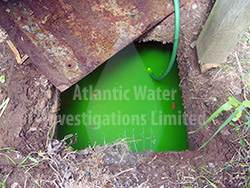
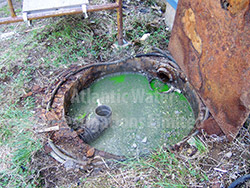
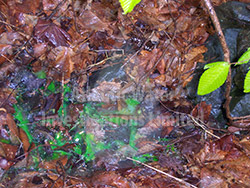

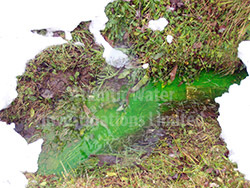
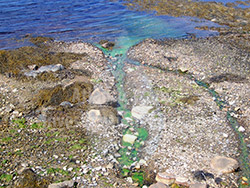 Dye testing is a method used to locate rain or
ground water entry points into the sanitary sewer system. During
this process, non-toxic dyed water is introduced into roof drain
leaders, driveway drains, or area drains. In some instances, dyed
water is injected into the ground around foundations to check for
the illegal connection of foundation drains. After introducing the
dyed water, the downstream sanitary sewer manhole is checked, or if
an inspection port is present, it is checked for dyed water. Dye
testing with a non-toxic dye is one way of determining where a pipe
or structure drains to if it is not obvious by observation or on
existing plans or records. By conducting dye testing, inappropriate
connections can be identified. For instance, if a dye is introduced
to a catch basin and the dye is then observed in the sanitary sewer
downstream from that point, this would indicate that the catch basin
is directly connected to the sanitary sewer system.
Dye testing is a method used to locate rain or
ground water entry points into the sanitary sewer system. During
this process, non-toxic dyed water is introduced into roof drain
leaders, driveway drains, or area drains. In some instances, dyed
water is injected into the ground around foundations to check for
the illegal connection of foundation drains. After introducing the
dyed water, the downstream sanitary sewer manhole is checked, or if
an inspection port is present, it is checked for dyed water. Dye
testing with a non-toxic dye is one way of determining where a pipe
or structure drains to if it is not obvious by observation or on
existing plans or records. By conducting dye testing, inappropriate
connections can be identified. For instance, if a dye is introduced
to a catch basin and the dye is then observed in the sanitary sewer
downstream from that point, this would indicate that the catch basin
is directly connected to the sanitary sewer system.